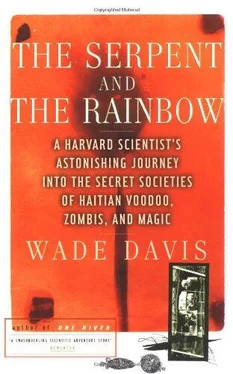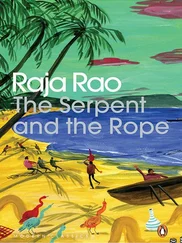Wade Davis - The Serpent and the Rainbow
Здесь есть возможность читать онлайн «Wade Davis - The Serpent and the Rainbow» весь текст электронной книги совершенно бесплатно (целиком полную версию без сокращений). В некоторых случаях можно слушать аудио, скачать через торрент в формате fb2 и присутствует краткое содержание. Год выпуска: 1985, Издательство: Simon & Schuster, Жанр: Старинная литература, на английском языке. Описание произведения, (предисловие) а так же отзывы посетителей доступны на портале библиотеки ЛибКат.
- Название:The Serpent and the Rainbow
- Автор:
- Издательство:Simon & Schuster
- Жанр:
- Год:1985
- ISBN:нет данных
- Рейтинг книги:5 / 5. Голосов: 1
-
Избранное:Добавить в избранное
- Отзывы:
-
Ваша оценка:
- 100
- 1
- 2
- 3
- 4
- 5
The Serpent and the Rainbow: краткое содержание, описание и аннотация
Предлагаем к чтению аннотацию, описание, краткое содержание или предисловие (зависит от того, что написал сам автор книги «The Serpent and the Rainbow»). Если вы не нашли необходимую информацию о книге — напишите в комментариях, мы постараемся отыскать её.
The Serpent and the Rainbow — читать онлайн бесплатно полную книгу (весь текст) целиком
Ниже представлен текст книги, разбитый по страницам. Система сохранения места последней прочитанной страницы, позволяет с удобством читать онлайн бесплатно книгу «The Serpent and the Rainbow», без необходимости каждый раз заново искать на чём Вы остановились. Поставьте закладку, и сможете в любой момент перейти на страницу, на которой закончили чтение.
Интервал:
Закладка:
That the plant is capable of inducing stupor is suggested in the origins of the name itself, which is derived from the dhatureas , bands of thieves in ancient India that used it to drug their intended victims. In the sixteenth century the Portuguese explorer Christoval Acosta found that Hindu prostitutes were so adept at using the seeds of the plant that they gave it in doses corresponding to the number of hours they wished their poor victims to remain unconscious. A later traveler to the Indies, Johann Albert de Mandelslo, noted in the mid-seventeenth century that the women, closely watched by their husbands yet tormented by their passion for the novel Europeans, drugged their mates with datura and then “prosecuted their delights, even in the presence of their husbands,” who sat utterly stupefied with their eyes wide open. A more macabre use was recorded from the New World, where the Chibcha Indians of highland Colombia administered a close relative of datura to the wives and slaves of dead kings, before burying them alive with their deceased masters.
The pharmacological evidence was solid. Datura was topically active, and in relatively modest dosage induced maddening hallucinations and delusions, followed by confusion, disorientation, and amnesia. Excessive doses resulted in stupor and death.
Yet I had another intuitive reason to implicate datura in the zombi phenomenon. Among many Amerindian groups, life is conceptually divided into stages beginning with birth and progressing through initiation, marriage, and finally death. The transition from one stage to the next is often marked by important ritualistic activity. When I had first heard Kline and Lehman describe Narcisse’s account of his resurrection from the grave, it had struck me as a kind of passage rite—a perverse inversion of the natural process of life and death. Perhaps more than any other drug, datura is associated with such transitional moments of passage, of initiation and death. The Luisena Indians of southern California, for example, felt that all youths had to undergo datura narcosis during their puberty rites in order to become men. The Algonquin and other tribes of northeastern North America also employed datura, calling it wysoccan . At puberty, adolescent males were confined in special longhouses and for two or three weeks ate nothing but the drug. During the course of their extended intoxication, the youths forgot what it was to be a boy and learned what it meant to be a man. In South America the Jivaro, or Shuar—the famed headhunters of eastern Ecuador—give a potion called maikua to young boys when at the age of six they must seek their souls. If the boy is fortunate, his soul will appear to him in the form of a large pair of creatures, often animals such as jaguars or anacondas. Later the soul will enter the body.
For many Indian tribes datura is closely associated with death. In parts of highland Peru it is called huaca , the Quechua name for grave, because of the belief that those intoxicated with the plant are able to divine the location of the tombs of their ancestors. The Zuni of the American Southwest chew datura during rain ceremonies, often placing the powdered roots in their eyes as they beseech the spirits of the dead to intercede with the gods for rain. Perhaps more than any other clue, it was this connection between datura and the forces of death and darkness that had offered the first indication of the makeup of the zombi poison.
Our attention naturally focused on Datura stramonium , the species known in Haiti as the zombi’s cucumber. Although this plant appears to have been native to Asia, its value as a drug was such that it was widely dispersed throughout Europe and Africa long before the time of Columbus. Because Schultes knew of no reports of the indigenous use of this species by Caribbean Indians, and because of the African origins of the Haitian, I was particularly curious about its distribution in West Africa.
Later that day, it came as no surprise to read that many tribes made use of Datura stramonium . The Hausas of Nigeria used the seeds to heighten the intoxication of ritual beverages. It was given to Fulani youths to excite them in the sharo contest, the ordeal of manhood. Witch doctors in Togo administered a drink of its leaves and the root of a potent fish poison (Lonchocarpus capassa) to disputants who appeared before them for a settlement. In many parts of West Africa the use of Datura stramonium in criminal poisonings still takes a unique form: women breed beetles and feed them on a species of the plant, and in turn use the feces to kill unfaithful lovers.
If the poison originated in Africa, it was reasonable to assume that the antidote that Kline had referred to would be found there as well. It was therefore with some satisfaction that I discovered that the recognized medical antidote for datura poisoning is derived from a West African plant. The substance is physostigmine, a drug first isolated from the Calabar bean (Physostigmine venenosum) , a climbing liana that grows in swampy coastal areas of West Africa from Sierra Leone south and east as far as the Cameroons. It is especially well known on the Calabar coast near the Gulf of Guinea at the mouth of the Niger River, precisely the region from which many of the forefathers of the Haitian people embarked as slaves for the plantations of the New World.
A brief sojourn in the ethnographic literature revealed that the eighteenth-century French plantation owners of Saint Domingue, now Haiti, chose their slaves with some care. The carnage on the plantations was horrendous, and as they found it cheaper to bring in adult Africans than to raise slaves from birth, prodigious numbers had to be imported. In a mere twelve years, for example, between 1779 and 1790, the slave ships that plied the coast of Africa from Sierra Leone to Mozambique unloaded close to four hundred thousand slaves in Saint Domingue. Although these unfortunate individuals came from virtually every corner of the continent, the plantation owners clearly had certain preferences. The Senegalese were highly regarded for their superior morality and taciturn character—an ironic assessment for the slavers to make—whereas the people from Sierra Leone and the Ivory and Gold Coasts were considered a stubborn group likely to revolt and desert. The Ibos of the southern Slave Coast of what is now Nigeria worked well but were prone to suicide. The people from the Congo and Angola were highly regarded, and large numbers of them were imported. But it was the peoples bought along the Slave Coast that were preferred above all others, and much of the European slave trade concentrated there. Such was the scale of the trade that in the Kingdom of Dahomey it became a national industry, with the economy of the entire country based on annual expeditions against neighboring peoples. Many of the captured victims—Nagos, Mahis, and Aradas of the western Yoruba, among others—were taken down the Niger, and there they fell into the hands of a notorious and opportunistic tribe of traders, the Efik of Old Calabar.
Originally fishermen, the Efik were ideally situated near the estuary of the Niger River to take advantage of the bitter competition for slaves. The prevailing winds and currents forced all ships returning to Europe or the Americas from the Ivory and Gold Coasts to pass eastward toward the Slave Coast and close to the shores of Efik lands. As avaricious middlemen soon equipped with European arms, the Efik came to control the entire trade with the hinterland; their name, in fact, is derived from an Ibibio-Efik word meaning “oppress,” a name received from those neighboring tribes on the lower Calabar and Cross rivers whom the Efik prevented from establishing direct contact with the white traders.
Читать дальшеИнтервал:
Закладка:
Похожие книги на «The Serpent and the Rainbow»
Представляем Вашему вниманию похожие книги на «The Serpent and the Rainbow» списком для выбора. Мы отобрали схожую по названию и смыслу литературу в надежде предоставить читателям больше вариантов отыскать новые, интересные, ещё непрочитанные произведения.
Обсуждение, отзывы о книге «The Serpent and the Rainbow» и просто собственные мнения читателей. Оставьте ваши комментарии, напишите, что Вы думаете о произведении, его смысле или главных героях. Укажите что конкретно понравилось, а что нет, и почему Вы так считаете.












